Analysis of Stakeholders in Development of Sustainable Tourism
VerifiedAdded on 2021/02/19
|12
|2889
|31
AI Summary
Contribute Materials
Your contribution can guide someone’s learning journey. Share your
documents today.
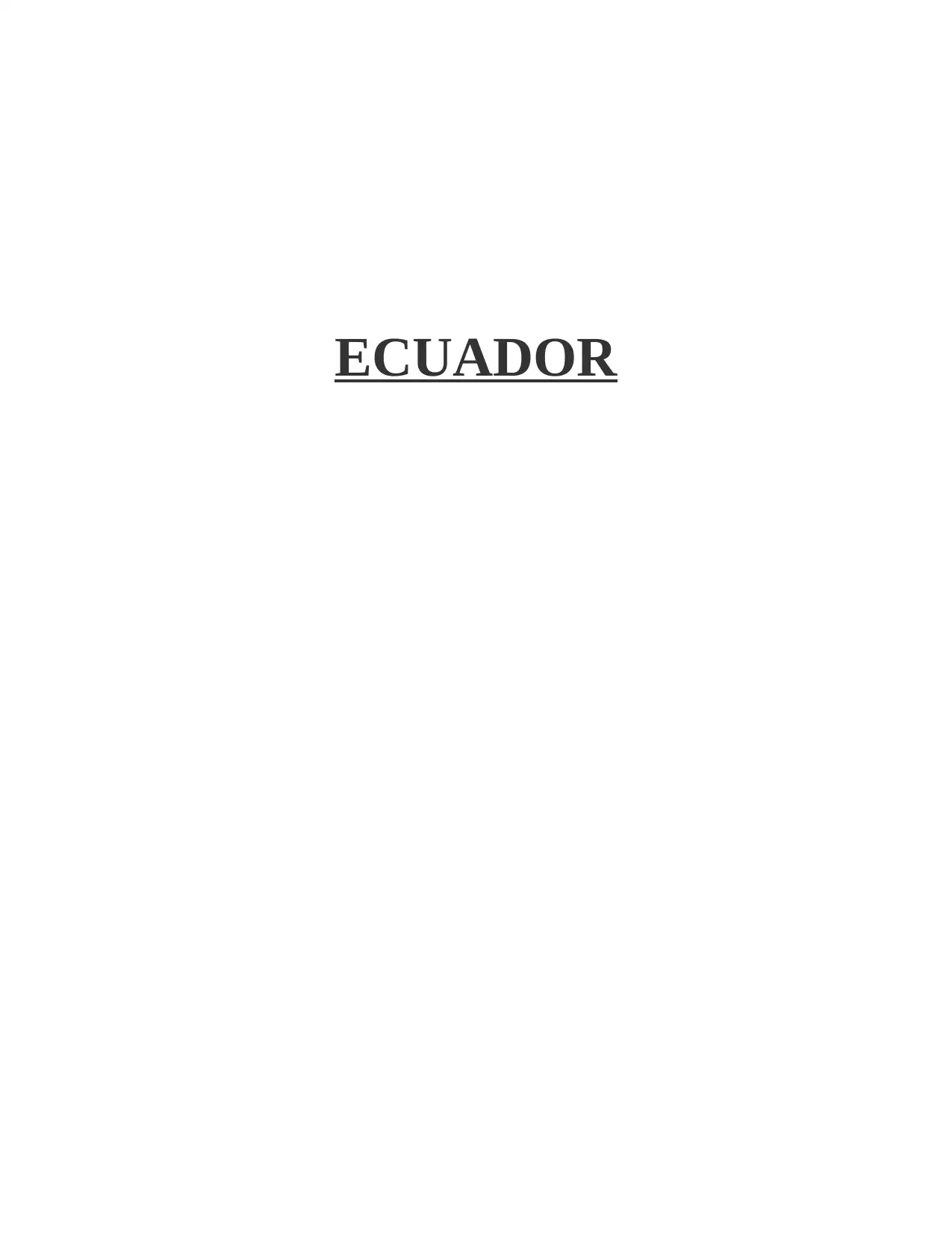
ECUADOR
Secure Best Marks with AI Grader
Need help grading? Try our AI Grader for instant feedback on your assignments.
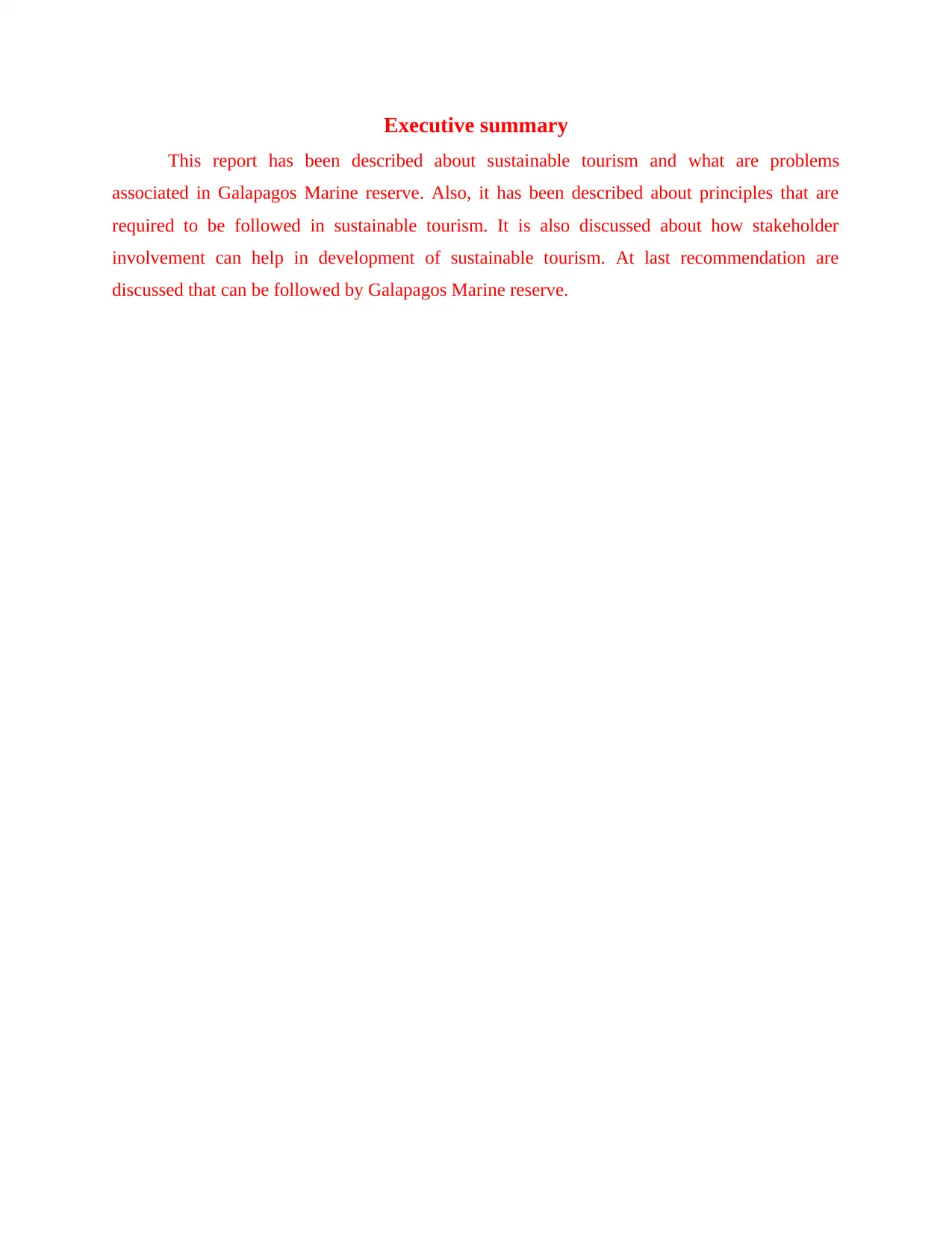
Executive summary
This report has been described about sustainable tourism and what are problems
associated in Galapagos Marine reserve. Also, it has been described about principles that are
required to be followed in sustainable tourism. It is also discussed about how stakeholder
involvement can help in development of sustainable tourism. At last recommendation are
discussed that can be followed by Galapagos Marine reserve.
This report has been described about sustainable tourism and what are problems
associated in Galapagos Marine reserve. Also, it has been described about principles that are
required to be followed in sustainable tourism. It is also discussed about how stakeholder
involvement can help in development of sustainable tourism. At last recommendation are
discussed that can be followed by Galapagos Marine reserve.
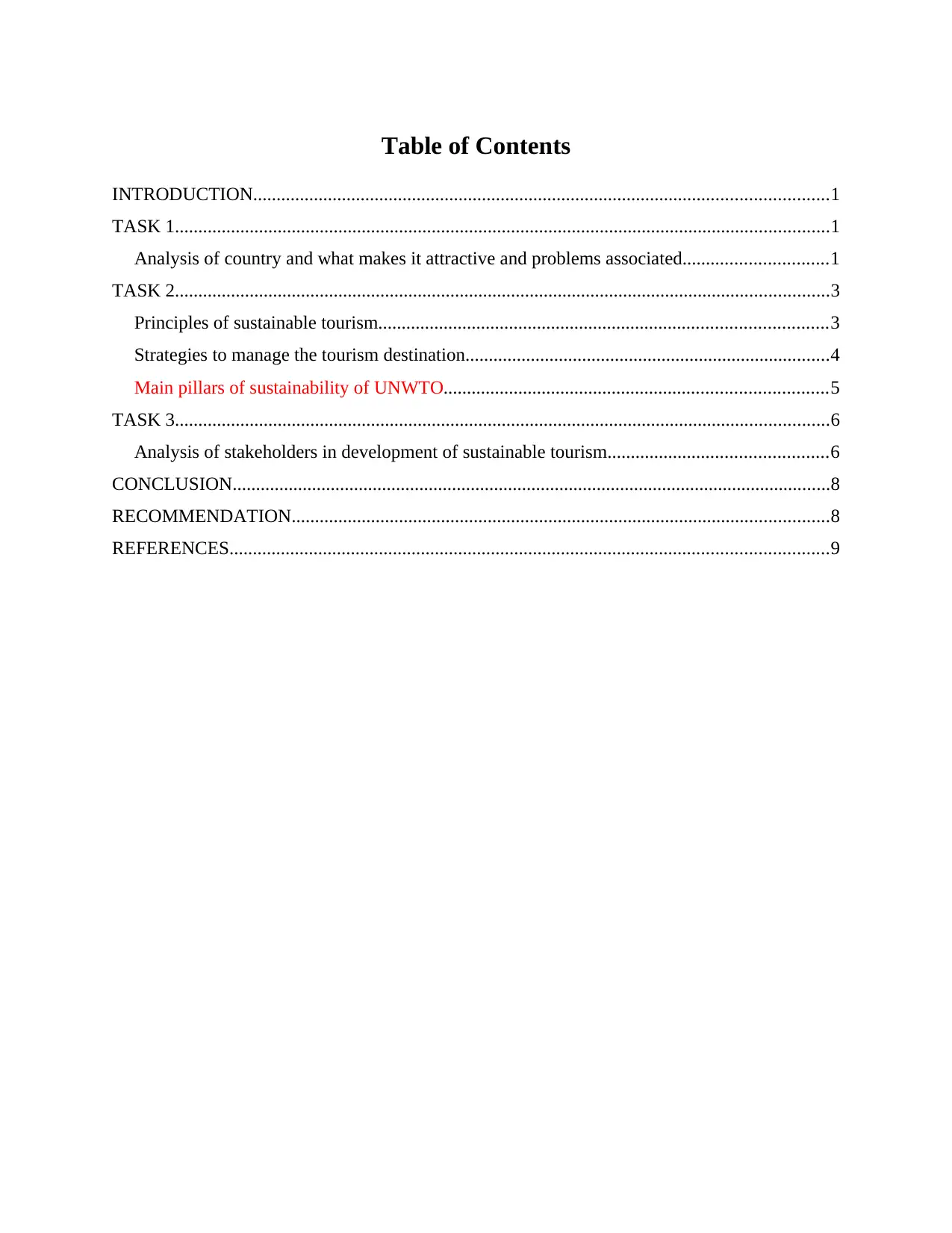
Table of Contents
INTRODUCTION...........................................................................................................................1
TASK 1............................................................................................................................................1
Analysis of country and what makes it attractive and problems associated...............................1
TASK 2............................................................................................................................................3
Principles of sustainable tourism................................................................................................3
Strategies to manage the tourism destination..............................................................................4
Main pillars of sustainability of UNWTO..................................................................................5
TASK 3............................................................................................................................................6
Analysis of stakeholders in development of sustainable tourism...............................................6
CONCLUSION................................................................................................................................8
RECOMMENDATION...................................................................................................................8
REFERENCES................................................................................................................................9
INTRODUCTION...........................................................................................................................1
TASK 1............................................................................................................................................1
Analysis of country and what makes it attractive and problems associated...............................1
TASK 2............................................................................................................................................3
Principles of sustainable tourism................................................................................................3
Strategies to manage the tourism destination..............................................................................4
Main pillars of sustainability of UNWTO..................................................................................5
TASK 3............................................................................................................................................6
Analysis of stakeholders in development of sustainable tourism...............................................6
CONCLUSION................................................................................................................................8
RECOMMENDATION...................................................................................................................8
REFERENCES................................................................................................................................9
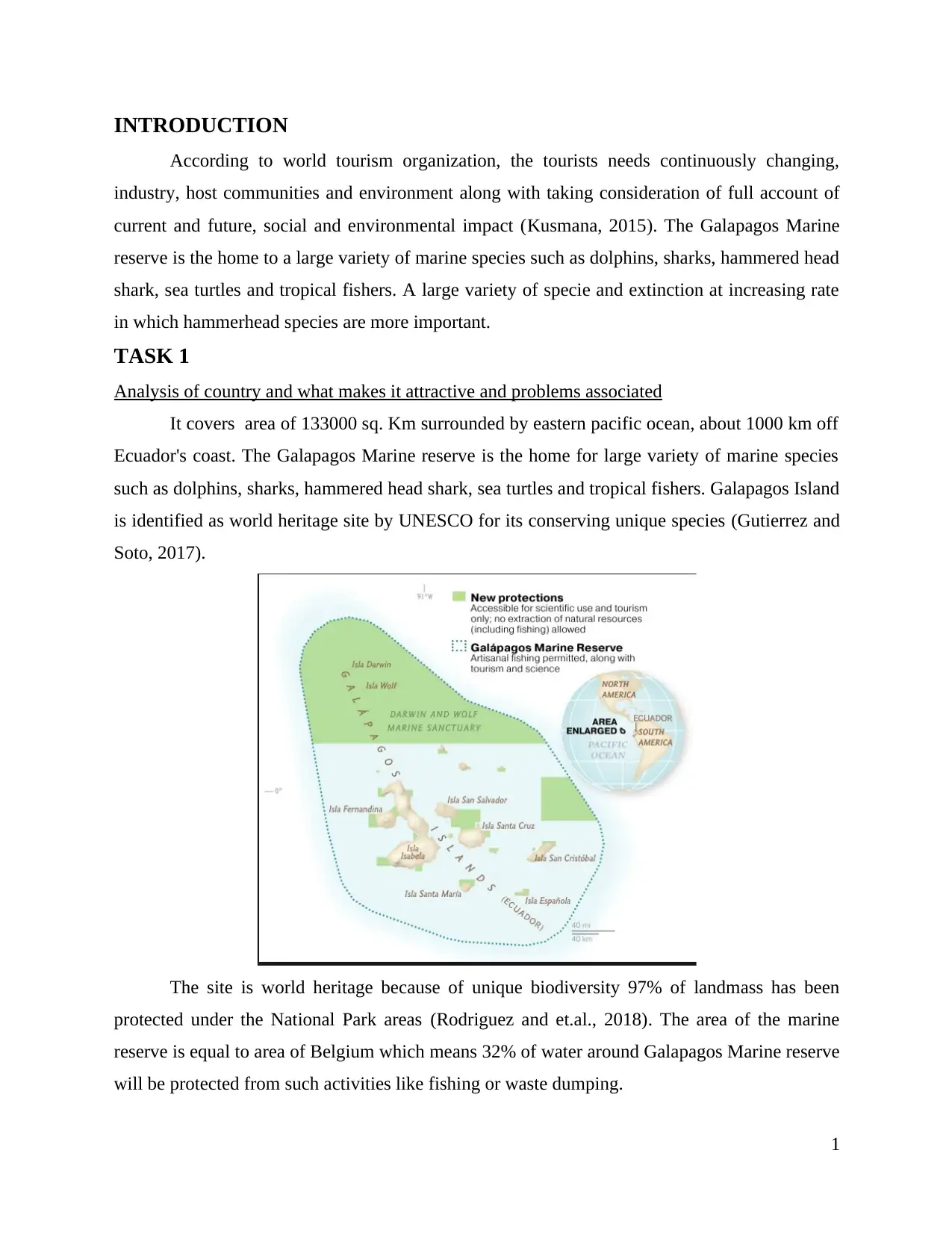
INTRODUCTION
According to world tourism organization, the tourists needs continuously changing,
industry, host communities and environment along with taking consideration of full account of
current and future, social and environmental impact (Kusmana, 2015). The Galapagos Marine
reserve is the home to a large variety of marine species such as dolphins, sharks, hammered head
shark, sea turtles and tropical fishers. A large variety of specie and extinction at increasing rate
in which hammerhead species are more important.
TASK 1
Analysis of country and what makes it attractive and problems associated
It covers area of 133000 sq. Km surrounded by eastern pacific ocean, about 1000 km off
Ecuador's coast. The Galapagos Marine reserve is the home for large variety of marine species
such as dolphins, sharks, hammered head shark, sea turtles and tropical fishers. Galapagos Island
is identified as world heritage site by UNESCO for its conserving unique species (Gutierrez and
Soto, 2017).
The site is world heritage because of unique biodiversity 97% of landmass has been
protected under the National Park areas (Rodriguez and et.al., 2018). The area of the marine
reserve is equal to area of Belgium which means 32% of water around Galapagos Marine reserve
will be protected from such activities like fishing or waste dumping.
1
According to world tourism organization, the tourists needs continuously changing,
industry, host communities and environment along with taking consideration of full account of
current and future, social and environmental impact (Kusmana, 2015). The Galapagos Marine
reserve is the home to a large variety of marine species such as dolphins, sharks, hammered head
shark, sea turtles and tropical fishers. A large variety of specie and extinction at increasing rate
in which hammerhead species are more important.
TASK 1
Analysis of country and what makes it attractive and problems associated
It covers area of 133000 sq. Km surrounded by eastern pacific ocean, about 1000 km off
Ecuador's coast. The Galapagos Marine reserve is the home for large variety of marine species
such as dolphins, sharks, hammered head shark, sea turtles and tropical fishers. Galapagos Island
is identified as world heritage site by UNESCO for its conserving unique species (Gutierrez and
Soto, 2017).
The site is world heritage because of unique biodiversity 97% of landmass has been
protected under the National Park areas (Rodriguez and et.al., 2018). The area of the marine
reserve is equal to area of Belgium which means 32% of water around Galapagos Marine reserve
will be protected from such activities like fishing or waste dumping.
1
Secure Best Marks with AI Grader
Need help grading? Try our AI Grader for instant feedback on your assignments.
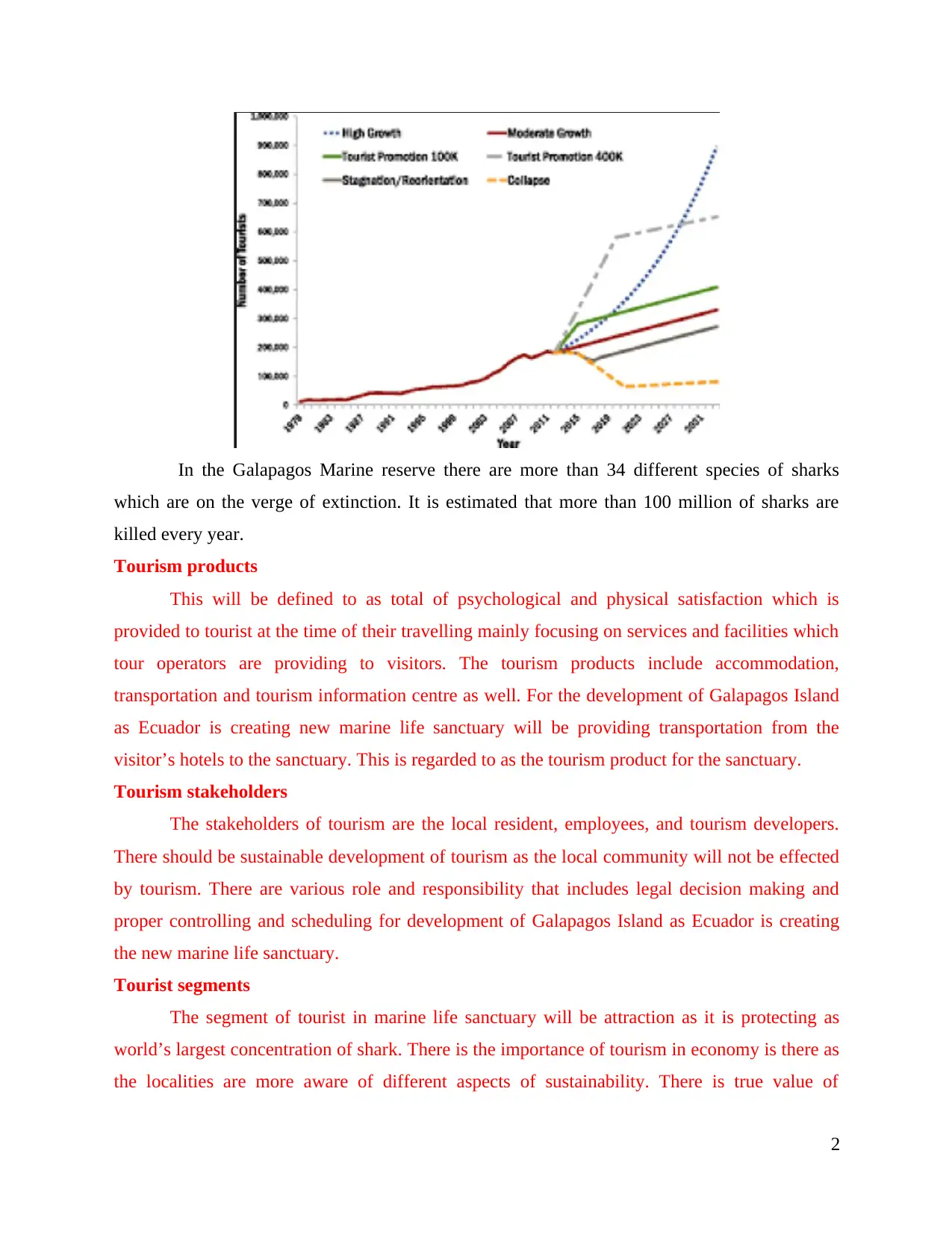
In the Galapagos Marine reserve there are more than 34 different species of sharks
which are on the verge of extinction. It is estimated that more than 100 million of sharks are
killed every year.
Tourism products
This will be defined to as total of psychological and physical satisfaction which is
provided to tourist at the time of their travelling mainly focusing on services and facilities which
tour operators are providing to visitors. The tourism products include accommodation,
transportation and tourism information centre as well. For the development of Galapagos Island
as Ecuador is creating new marine life sanctuary will be providing transportation from the
visitor’s hotels to the sanctuary. This is regarded to as the tourism product for the sanctuary.
Tourism stakeholders
The stakeholders of tourism are the local resident, employees, and tourism developers.
There should be sustainable development of tourism as the local community will not be effected
by tourism. There are various role and responsibility that includes legal decision making and
proper controlling and scheduling for development of Galapagos Island as Ecuador is creating
the new marine life sanctuary.
Tourist segments
The segment of tourist in marine life sanctuary will be attraction as it is protecting as
world’s largest concentration of shark. There is the importance of tourism in economy is there as
the localities are more aware of different aspects of sustainability. There is true value of
2
which are on the verge of extinction. It is estimated that more than 100 million of sharks are
killed every year.
Tourism products
This will be defined to as total of psychological and physical satisfaction which is
provided to tourist at the time of their travelling mainly focusing on services and facilities which
tour operators are providing to visitors. The tourism products include accommodation,
transportation and tourism information centre as well. For the development of Galapagos Island
as Ecuador is creating new marine life sanctuary will be providing transportation from the
visitor’s hotels to the sanctuary. This is regarded to as the tourism product for the sanctuary.
Tourism stakeholders
The stakeholders of tourism are the local resident, employees, and tourism developers.
There should be sustainable development of tourism as the local community will not be effected
by tourism. There are various role and responsibility that includes legal decision making and
proper controlling and scheduling for development of Galapagos Island as Ecuador is creating
the new marine life sanctuary.
Tourist segments
The segment of tourist in marine life sanctuary will be attraction as it is protecting as
world’s largest concentration of shark. There is the importance of tourism in economy is there as
the localities are more aware of different aspects of sustainability. There is true value of
2
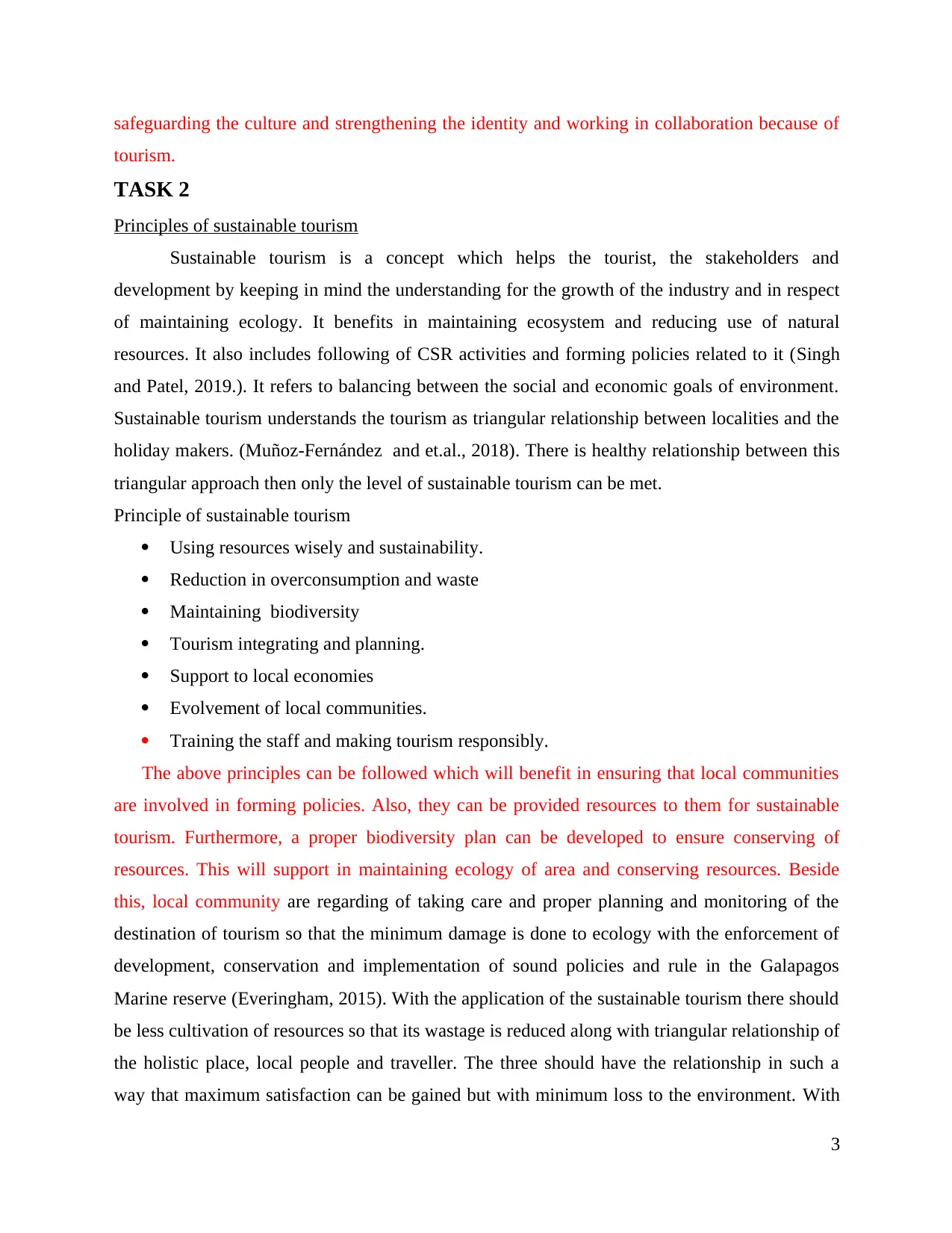
safeguarding the culture and strengthening the identity and working in collaboration because of
tourism.
TASK 2
Principles of sustainable tourism
Sustainable tourism is a concept which helps the tourist, the stakeholders and
development by keeping in mind the understanding for the growth of the industry and in respect
of maintaining ecology. It benefits in maintaining ecosystem and reducing use of natural
resources. It also includes following of CSR activities and forming policies related to it (Singh
and Patel, 2019.). It refers to balancing between the social and economic goals of environment.
Sustainable tourism understands the tourism as triangular relationship between localities and the
holiday makers. (Muñoz-Fernández and et.al., 2018). There is healthy relationship between this
triangular approach then only the level of sustainable tourism can be met.
Principle of sustainable tourism
Using resources wisely and sustainability.
Reduction in overconsumption and waste
Maintaining biodiversity
Tourism integrating and planning.
Support to local economies
Evolvement of local communities.
Training the staff and making tourism responsibly.
The above principles can be followed which will benefit in ensuring that local communities
are involved in forming policies. Also, they can be provided resources to them for sustainable
tourism. Furthermore, a proper biodiversity plan can be developed to ensure conserving of
resources. This will support in maintaining ecology of area and conserving resources. Beside
this, local community are regarding of taking care and proper planning and monitoring of the
destination of tourism so that the minimum damage is done to ecology with the enforcement of
development, conservation and implementation of sound policies and rule in the Galapagos
Marine reserve (Everingham, 2015). With the application of the sustainable tourism there should
be less cultivation of resources so that its wastage is reduced along with triangular relationship of
the holistic place, local people and traveller. The three should have the relationship in such a
way that maximum satisfaction can be gained but with minimum loss to the environment. With
3
tourism.
TASK 2
Principles of sustainable tourism
Sustainable tourism is a concept which helps the tourist, the stakeholders and
development by keeping in mind the understanding for the growth of the industry and in respect
of maintaining ecology. It benefits in maintaining ecosystem and reducing use of natural
resources. It also includes following of CSR activities and forming policies related to it (Singh
and Patel, 2019.). It refers to balancing between the social and economic goals of environment.
Sustainable tourism understands the tourism as triangular relationship between localities and the
holiday makers. (Muñoz-Fernández and et.al., 2018). There is healthy relationship between this
triangular approach then only the level of sustainable tourism can be met.
Principle of sustainable tourism
Using resources wisely and sustainability.
Reduction in overconsumption and waste
Maintaining biodiversity
Tourism integrating and planning.
Support to local economies
Evolvement of local communities.
Training the staff and making tourism responsibly.
The above principles can be followed which will benefit in ensuring that local communities
are involved in forming policies. Also, they can be provided resources to them for sustainable
tourism. Furthermore, a proper biodiversity plan can be developed to ensure conserving of
resources. This will support in maintaining ecology of area and conserving resources. Beside
this, local community are regarding of taking care and proper planning and monitoring of the
destination of tourism so that the minimum damage is done to ecology with the enforcement of
development, conservation and implementation of sound policies and rule in the Galapagos
Marine reserve (Everingham, 2015). With the application of the sustainable tourism there should
be less cultivation of resources so that its wastage is reduced along with triangular relationship of
the holistic place, local people and traveller. The three should have the relationship in such a
way that maximum satisfaction can be gained but with minimum loss to the environment. With
3
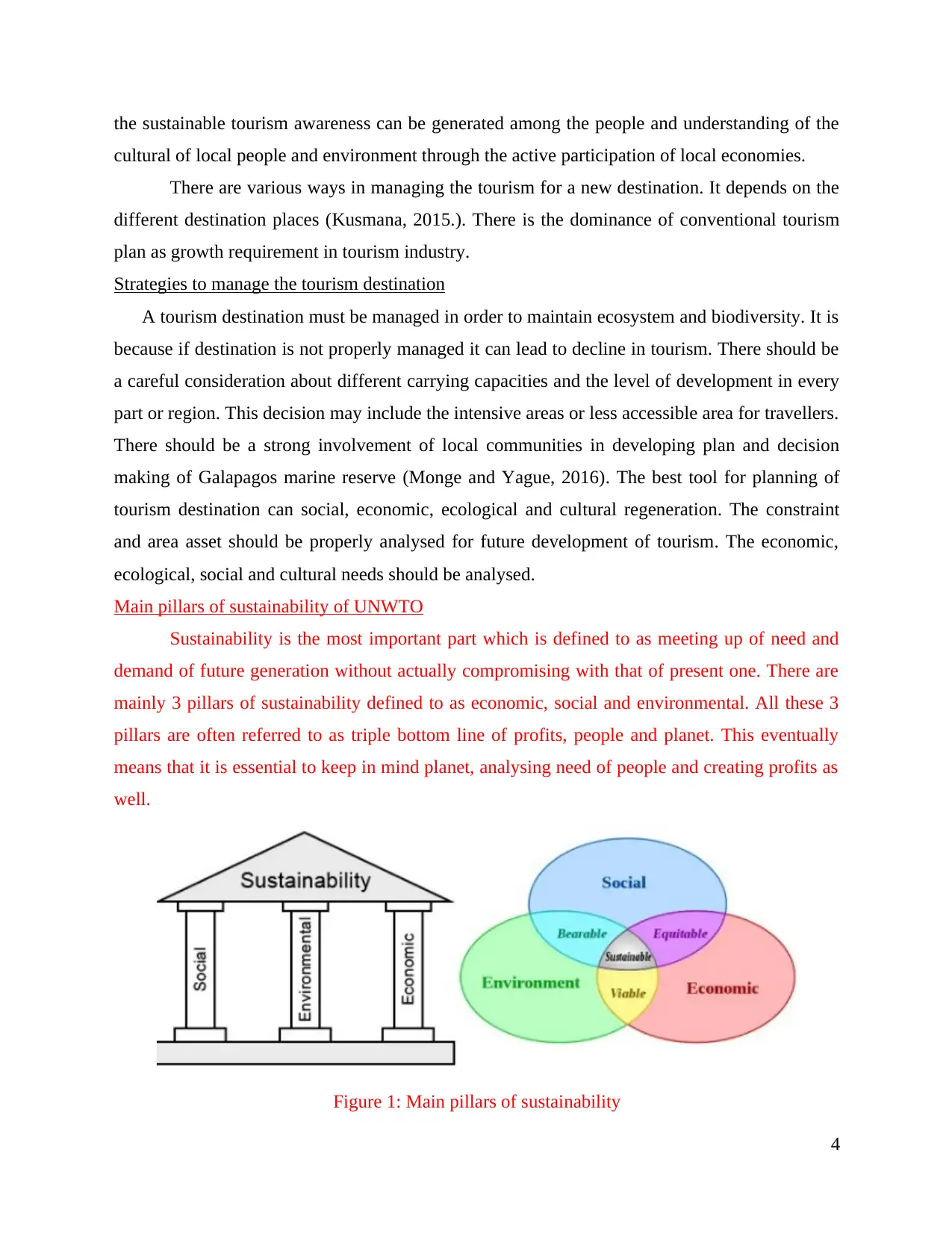
the sustainable tourism awareness can be generated among the people and understanding of the
cultural of local people and environment through the active participation of local economies.
There are various ways in managing the tourism for a new destination. It depends on the
different destination places (Kusmana, 2015.). There is the dominance of conventional tourism
plan as growth requirement in tourism industry.
Strategies to manage the tourism destination
A tourism destination must be managed in order to maintain ecosystem and biodiversity. It is
because if destination is not properly managed it can lead to decline in tourism. There should be
a careful consideration about different carrying capacities and the level of development in every
part or region. This decision may include the intensive areas or less accessible area for travellers.
There should be a strong involvement of local communities in developing plan and decision
making of Galapagos marine reserve (Monge and Yague, 2016). The best tool for planning of
tourism destination can social, economic, ecological and cultural regeneration. The constraint
and area asset should be properly analysed for future development of tourism. The economic,
ecological, social and cultural needs should be analysed.
Main pillars of sustainability of UNWTO
Sustainability is the most important part which is defined to as meeting up of need and
demand of future generation without actually compromising with that of present one. There are
mainly 3 pillars of sustainability defined to as economic, social and environmental. All these 3
pillars are often referred to as triple bottom line of profits, people and planet. This eventually
means that it is essential to keep in mind planet, analysing need of people and creating profits as
well.
Figure 1: Main pillars of sustainability
4
cultural of local people and environment through the active participation of local economies.
There are various ways in managing the tourism for a new destination. It depends on the
different destination places (Kusmana, 2015.). There is the dominance of conventional tourism
plan as growth requirement in tourism industry.
Strategies to manage the tourism destination
A tourism destination must be managed in order to maintain ecosystem and biodiversity. It is
because if destination is not properly managed it can lead to decline in tourism. There should be
a careful consideration about different carrying capacities and the level of development in every
part or region. This decision may include the intensive areas or less accessible area for travellers.
There should be a strong involvement of local communities in developing plan and decision
making of Galapagos marine reserve (Monge and Yague, 2016). The best tool for planning of
tourism destination can social, economic, ecological and cultural regeneration. The constraint
and area asset should be properly analysed for future development of tourism. The economic,
ecological, social and cultural needs should be analysed.
Main pillars of sustainability of UNWTO
Sustainability is the most important part which is defined to as meeting up of need and
demand of future generation without actually compromising with that of present one. There are
mainly 3 pillars of sustainability defined to as economic, social and environmental. All these 3
pillars are often referred to as triple bottom line of profits, people and planet. This eventually
means that it is essential to keep in mind planet, analysing need of people and creating profits as
well.
Figure 1: Main pillars of sustainability
4
Paraphrase This Document
Need a fresh take? Get an instant paraphrase of this document with our AI Paraphraser
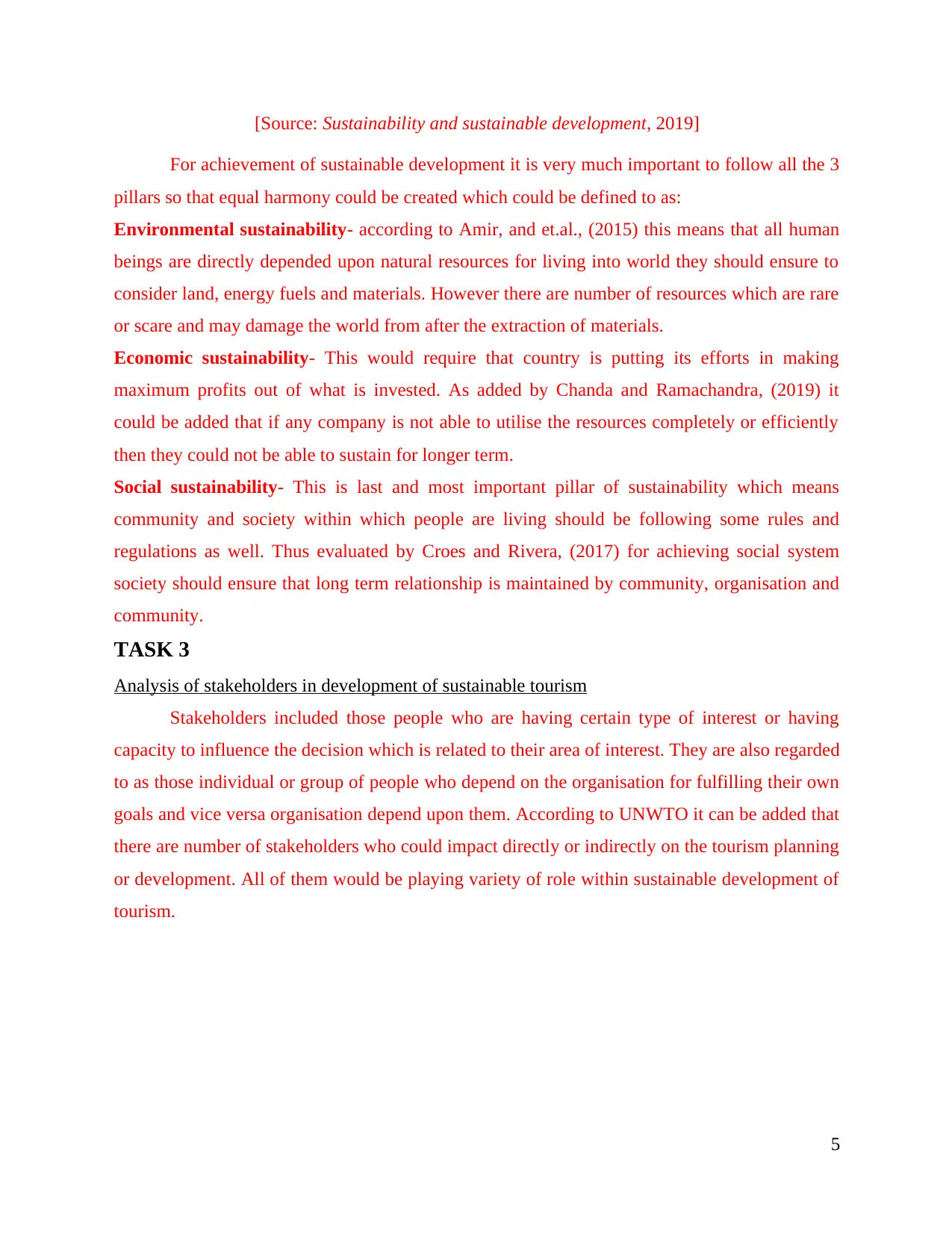
[Source: Sustainability and sustainable development, 2019]
For achievement of sustainable development it is very much important to follow all the 3
pillars so that equal harmony could be created which could be defined to as:
Environmental sustainability- according to Amir, and et.al., (2015) this means that all human
beings are directly depended upon natural resources for living into world they should ensure to
consider land, energy fuels and materials. However there are number of resources which are rare
or scare and may damage the world from after the extraction of materials.
Economic sustainability- This would require that country is putting its efforts in making
maximum profits out of what is invested. As added by Chanda and Ramachandra, (2019) it
could be added that if any company is not able to utilise the resources completely or efficiently
then they could not be able to sustain for longer term.
Social sustainability- This is last and most important pillar of sustainability which means
community and society within which people are living should be following some rules and
regulations as well. Thus evaluated by Croes and Rivera, (2017) for achieving social system
society should ensure that long term relationship is maintained by community, organisation and
community.
TASK 3
Analysis of stakeholders in development of sustainable tourism
Stakeholders included those people who are having certain type of interest or having
capacity to influence the decision which is related to their area of interest. They are also regarded
to as those individual or group of people who depend on the organisation for fulfilling their own
goals and vice versa organisation depend upon them. According to UNWTO it can be added that
there are number of stakeholders who could impact directly or indirectly on the tourism planning
or development. All of them would be playing variety of role within sustainable development of
tourism.
5
For achievement of sustainable development it is very much important to follow all the 3
pillars so that equal harmony could be created which could be defined to as:
Environmental sustainability- according to Amir, and et.al., (2015) this means that all human
beings are directly depended upon natural resources for living into world they should ensure to
consider land, energy fuels and materials. However there are number of resources which are rare
or scare and may damage the world from after the extraction of materials.
Economic sustainability- This would require that country is putting its efforts in making
maximum profits out of what is invested. As added by Chanda and Ramachandra, (2019) it
could be added that if any company is not able to utilise the resources completely or efficiently
then they could not be able to sustain for longer term.
Social sustainability- This is last and most important pillar of sustainability which means
community and society within which people are living should be following some rules and
regulations as well. Thus evaluated by Croes and Rivera, (2017) for achieving social system
society should ensure that long term relationship is maintained by community, organisation and
community.
TASK 3
Analysis of stakeholders in development of sustainable tourism
Stakeholders included those people who are having certain type of interest or having
capacity to influence the decision which is related to their area of interest. They are also regarded
to as those individual or group of people who depend on the organisation for fulfilling their own
goals and vice versa organisation depend upon them. According to UNWTO it can be added that
there are number of stakeholders who could impact directly or indirectly on the tourism planning
or development. All of them would be playing variety of role within sustainable development of
tourism.
5
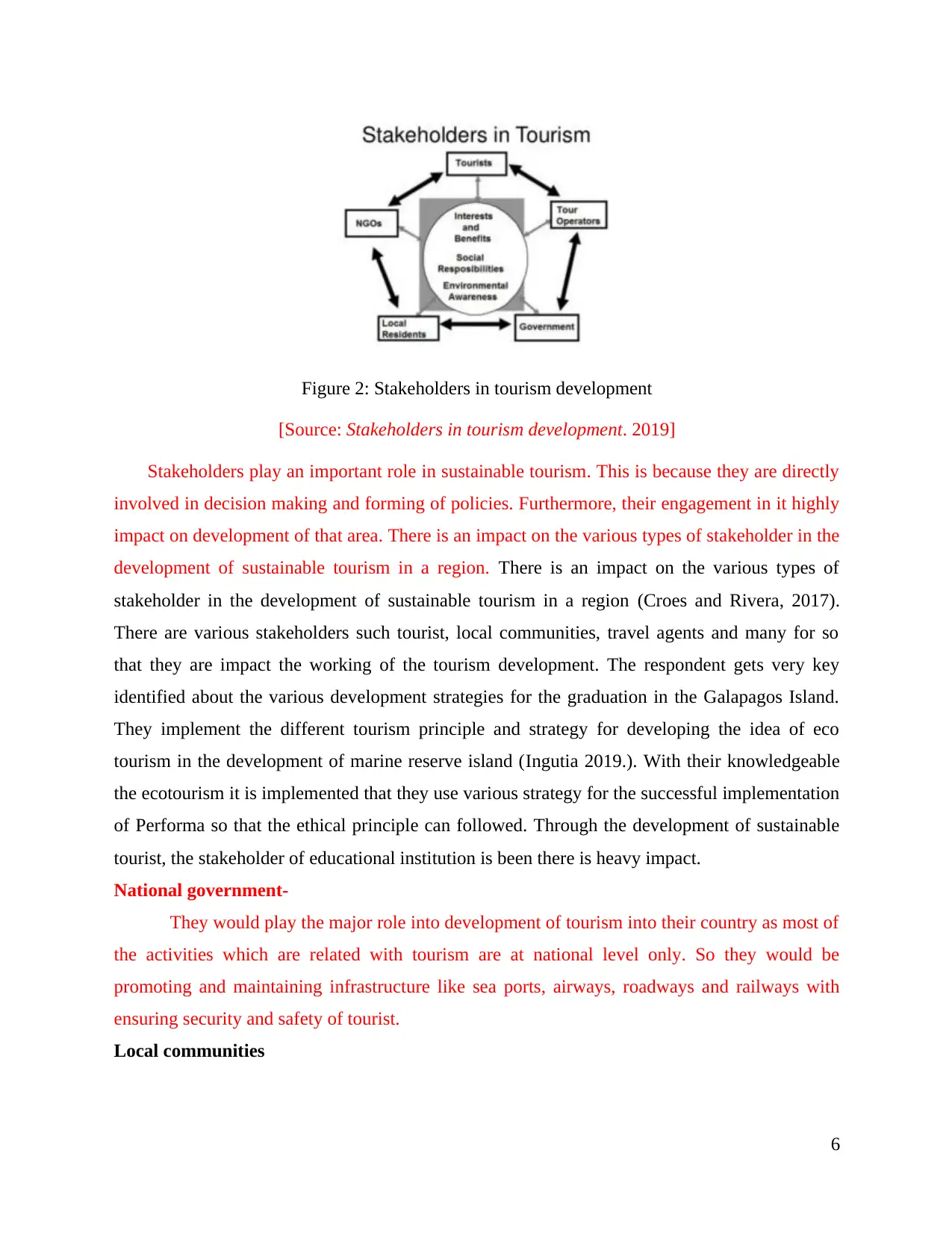
Figure 2: Stakeholders in tourism development
[Source: Stakeholders in tourism development. 2019]
Stakeholders play an important role in sustainable tourism. This is because they are directly
involved in decision making and forming of policies. Furthermore, their engagement in it highly
impact on development of that area. There is an impact on the various types of stakeholder in the
development of sustainable tourism in a region. There is an impact on the various types of
stakeholder in the development of sustainable tourism in a region (Croes and Rivera, 2017).
There are various stakeholders such tourist, local communities, travel agents and many for so
that they are impact the working of the tourism development. The respondent gets very key
identified about the various development strategies for the graduation in the Galapagos Island.
They implement the different tourism principle and strategy for developing the idea of eco
tourism in the development of marine reserve island (Ingutia 2019.). With their knowledgeable
the ecotourism it is implemented that they use various strategy for the successful implementation
of Performa so that the ethical principle can followed. Through the development of sustainable
tourist, the stakeholder of educational institution is been there is heavy impact.
National government-
They would play the major role into development of tourism into their country as most of
the activities which are related with tourism are at national level only. So they would be
promoting and maintaining infrastructure like sea ports, airways, roadways and railways with
ensuring security and safety of tourist.
Local communities
6
[Source: Stakeholders in tourism development. 2019]
Stakeholders play an important role in sustainable tourism. This is because they are directly
involved in decision making and forming of policies. Furthermore, their engagement in it highly
impact on development of that area. There is an impact on the various types of stakeholder in the
development of sustainable tourism in a region. There is an impact on the various types of
stakeholder in the development of sustainable tourism in a region (Croes and Rivera, 2017).
There are various stakeholders such tourist, local communities, travel agents and many for so
that they are impact the working of the tourism development. The respondent gets very key
identified about the various development strategies for the graduation in the Galapagos Island.
They implement the different tourism principle and strategy for developing the idea of eco
tourism in the development of marine reserve island (Ingutia 2019.). With their knowledgeable
the ecotourism it is implemented that they use various strategy for the successful implementation
of Performa so that the ethical principle can followed. Through the development of sustainable
tourist, the stakeholder of educational institution is been there is heavy impact.
National government-
They would play the major role into development of tourism into their country as most of
the activities which are related with tourism are at national level only. So they would be
promoting and maintaining infrastructure like sea ports, airways, roadways and railways with
ensuring security and safety of tourist.
Local communities
6
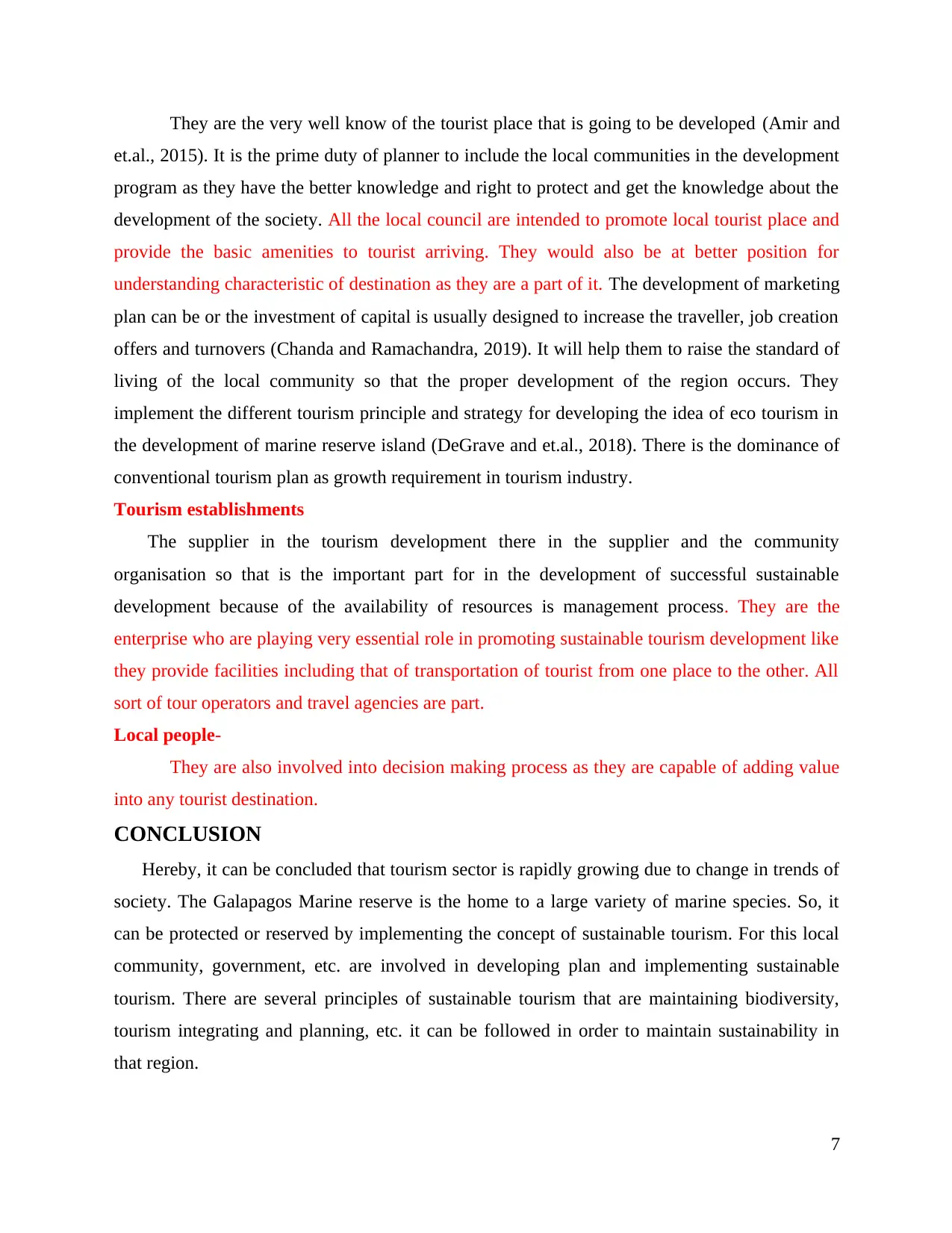
They are the very well know of the tourist place that is going to be developed (Amir and
et.al., 2015). It is the prime duty of planner to include the local communities in the development
program as they have the better knowledge and right to protect and get the knowledge about the
development of the society. All the local council are intended to promote local tourist place and
provide the basic amenities to tourist arriving. They would also be at better position for
understanding characteristic of destination as they are a part of it. The development of marketing
plan can be or the investment of capital is usually designed to increase the traveller, job creation
offers and turnovers (Chanda and Ramachandra, 2019). It will help them to raise the standard of
living of the local community so that the proper development of the region occurs. They
implement the different tourism principle and strategy for developing the idea of eco tourism in
the development of marine reserve island (DeGrave and et.al., 2018). There is the dominance of
conventional tourism plan as growth requirement in tourism industry.
Tourism establishments
The supplier in the tourism development there in the supplier and the community
organisation so that is the important part for in the development of successful sustainable
development because of the availability of resources is management process. They are the
enterprise who are playing very essential role in promoting sustainable tourism development like
they provide facilities including that of transportation of tourist from one place to the other. All
sort of tour operators and travel agencies are part.
Local people-
They are also involved into decision making process as they are capable of adding value
into any tourist destination.
CONCLUSION
Hereby, it can be concluded that tourism sector is rapidly growing due to change in trends of
society. The Galapagos Marine reserve is the home to a large variety of marine species. So, it
can be protected or reserved by implementing the concept of sustainable tourism. For this local
community, government, etc. are involved in developing plan and implementing sustainable
tourism. There are several principles of sustainable tourism that are maintaining biodiversity,
tourism integrating and planning, etc. it can be followed in order to maintain sustainability in
that region.
7
et.al., 2015). It is the prime duty of planner to include the local communities in the development
program as they have the better knowledge and right to protect and get the knowledge about the
development of the society. All the local council are intended to promote local tourist place and
provide the basic amenities to tourist arriving. They would also be at better position for
understanding characteristic of destination as they are a part of it. The development of marketing
plan can be or the investment of capital is usually designed to increase the traveller, job creation
offers and turnovers (Chanda and Ramachandra, 2019). It will help them to raise the standard of
living of the local community so that the proper development of the region occurs. They
implement the different tourism principle and strategy for developing the idea of eco tourism in
the development of marine reserve island (DeGrave and et.al., 2018). There is the dominance of
conventional tourism plan as growth requirement in tourism industry.
Tourism establishments
The supplier in the tourism development there in the supplier and the community
organisation so that is the important part for in the development of successful sustainable
development because of the availability of resources is management process. They are the
enterprise who are playing very essential role in promoting sustainable tourism development like
they provide facilities including that of transportation of tourist from one place to the other. All
sort of tour operators and travel agencies are part.
Local people-
They are also involved into decision making process as they are capable of adding value
into any tourist destination.
CONCLUSION
Hereby, it can be concluded that tourism sector is rapidly growing due to change in trends of
society. The Galapagos Marine reserve is the home to a large variety of marine species. So, it
can be protected or reserved by implementing the concept of sustainable tourism. For this local
community, government, etc. are involved in developing plan and implementing sustainable
tourism. There are several principles of sustainable tourism that are maintaining biodiversity,
tourism integrating and planning, etc. it can be followed in order to maintain sustainability in
that region.
7
Secure Best Marks with AI Grader
Need help grading? Try our AI Grader for instant feedback on your assignments.
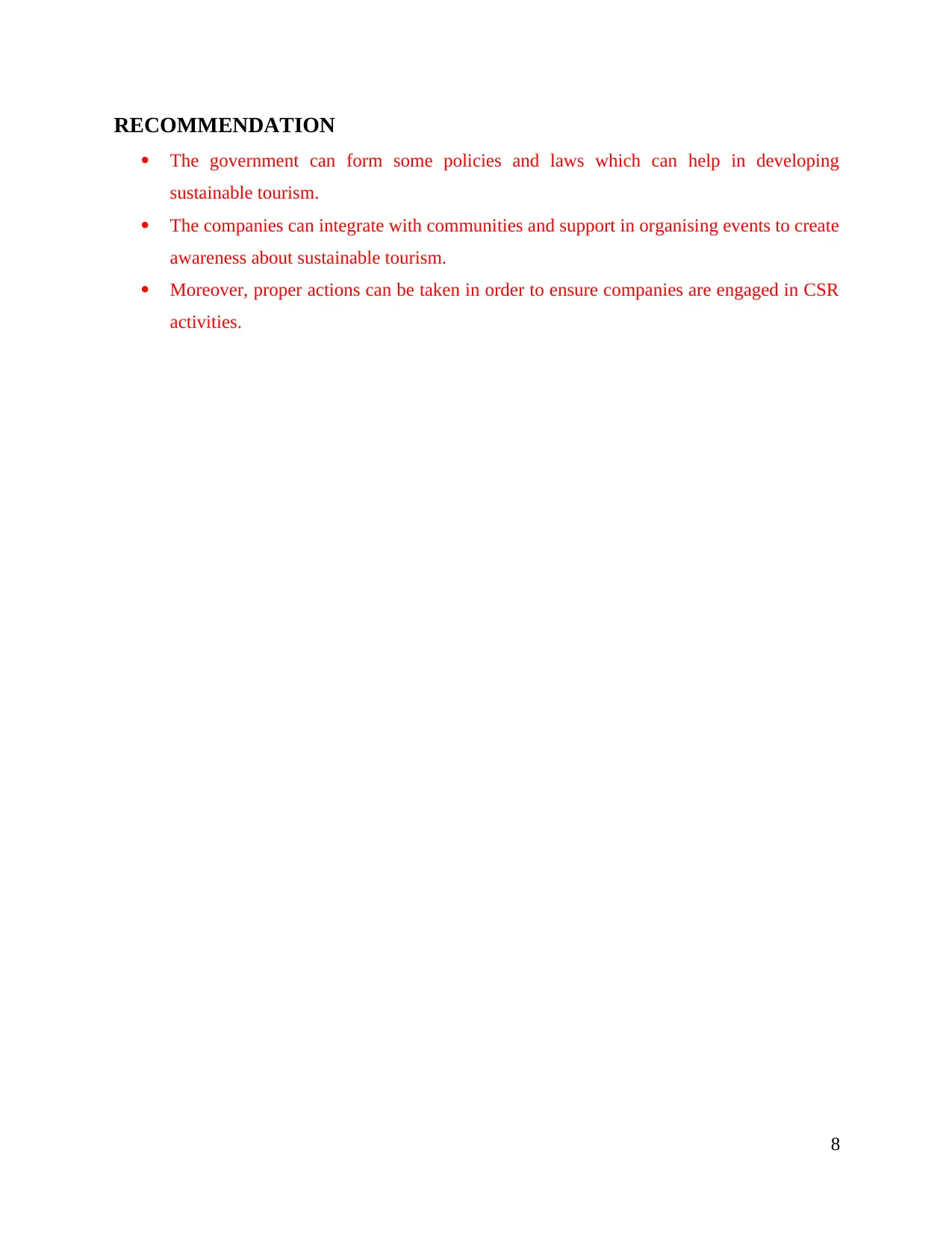
RECOMMENDATION
The government can form some policies and laws which can help in developing
sustainable tourism.
The companies can integrate with communities and support in organising events to create
awareness about sustainable tourism.
Moreover, proper actions can be taken in order to ensure companies are engaged in CSR
activities.
8
The government can form some policies and laws which can help in developing
sustainable tourism.
The companies can integrate with communities and support in organising events to create
awareness about sustainable tourism.
Moreover, proper actions can be taken in order to ensure companies are engaged in CSR
activities.
8

REFERENCES
Books and Journals
Amir, A.F. and et.al., 2015. Sustainable tourism development: A study on community resilience
for rural tourism in Malaysia. Procedia-Social and Behavioral Sciences. 168. pp.116-122.
Chanda, S. and Ramachandra, T.V., 2019. Vegetation in the Sacred Groves Across India: A
Review. Research & Reviews: Journal of Ecology. 8(1). pp.29-38.
Croes, R. and Rivera, M.A., 2017. Tourism’s potential to benefit the poor: A social accounting
matrix model applied to Ecuador. Tourism Economics. 23(1). pp.29-48.
DeGrave, J.R. and et.al., 2018. Tourism Impacts on Indigenous Communities within Ecuador: A
Critical Analysis.
Everingham, P., 2015. Intercultural exchange and mutuality in volunteer tourism: The case of
intercambio in Ecuador. Tourist Studies. 15(2). pp.175-190.
Gutierrez, I. and Soto, J.M., 2017. SUSTAINABLE USE OF THE BUFFER ZONE OF EL
ANGEL ECOLOGICAL RESERVE, ECUADOR. Бюллетень науки и практики. (4).
pp.188-190.
Ingutia, R., 2019. Does marginalisation in education stall the progress of sustainable
development goals?. Education 3-13, pp.1-17.
Kusmana, C., 2015. Integrated sustainable mangrove forest management. Jurnal Pengelolaan
Sumberdaya Alam dan Lingkungan (Journal of Natural Resources and Environmental
Management), 5(1), p.1.
McKenzie, S. and Abdulkadri, A., 2018. Mechanisms to accelerate the implementation of the
Sustainable Development Goals in the Caribbean.
Monge, J.G. and Yagüe, P., 2016. Sustainable Tourism Development: Tren Crucero del
Ecuador. Estudios y Perspectivas en Turismo. 25(1). pp.57-72.
Muñoz-Fernández, G.A. and et.al., 2018. Heritage tourism in the Andes: the case of Cuenca,
Ecuador. Anatolia. 29(3). pp.326-336.
Rodriguez, J. and et.al., 2018. Sustainable Tourism Experiences in Ecuador; Implementing
knowledge’Social Construction process in a rural community. Journal of Arts and
Humanities. 7(4). pp.32-47.
Singh, A. and Patel, M., 2019. Achieving inclusive devlopment through smart village.
Singleton, J.A., 2015, November. Sustainable me-a pharmacist’s role in reducing the carbon
footprint of healthcare delivery. In APSA-ASCEPT Joint Scientific Meeting 2015 Book of
Abstracts.
Spenceley, A. and Meyer, D. eds., 2017. Tourism and poverty reduction: Principles and impacts
in developing countries. Routledge.
Sustainability and sustainable development. 2019. [Online]. Accessed through:
<http://www.circularecology.com/sustainability-and-sustainable-
development.html#.XTwy5o4zaM9 >.
Stakeholders in tourism development. 2019. [Online]. Accessed through:
<https://www.howandwhat.net/stakeholders-tourism-development/>.
9
Books and Journals
Amir, A.F. and et.al., 2015. Sustainable tourism development: A study on community resilience
for rural tourism in Malaysia. Procedia-Social and Behavioral Sciences. 168. pp.116-122.
Chanda, S. and Ramachandra, T.V., 2019. Vegetation in the Sacred Groves Across India: A
Review. Research & Reviews: Journal of Ecology. 8(1). pp.29-38.
Croes, R. and Rivera, M.A., 2017. Tourism’s potential to benefit the poor: A social accounting
matrix model applied to Ecuador. Tourism Economics. 23(1). pp.29-48.
DeGrave, J.R. and et.al., 2018. Tourism Impacts on Indigenous Communities within Ecuador: A
Critical Analysis.
Everingham, P., 2015. Intercultural exchange and mutuality in volunteer tourism: The case of
intercambio in Ecuador. Tourist Studies. 15(2). pp.175-190.
Gutierrez, I. and Soto, J.M., 2017. SUSTAINABLE USE OF THE BUFFER ZONE OF EL
ANGEL ECOLOGICAL RESERVE, ECUADOR. Бюллетень науки и практики. (4).
pp.188-190.
Ingutia, R., 2019. Does marginalisation in education stall the progress of sustainable
development goals?. Education 3-13, pp.1-17.
Kusmana, C., 2015. Integrated sustainable mangrove forest management. Jurnal Pengelolaan
Sumberdaya Alam dan Lingkungan (Journal of Natural Resources and Environmental
Management), 5(1), p.1.
McKenzie, S. and Abdulkadri, A., 2018. Mechanisms to accelerate the implementation of the
Sustainable Development Goals in the Caribbean.
Monge, J.G. and Yagüe, P., 2016. Sustainable Tourism Development: Tren Crucero del
Ecuador. Estudios y Perspectivas en Turismo. 25(1). pp.57-72.
Muñoz-Fernández, G.A. and et.al., 2018. Heritage tourism in the Andes: the case of Cuenca,
Ecuador. Anatolia. 29(3). pp.326-336.
Rodriguez, J. and et.al., 2018. Sustainable Tourism Experiences in Ecuador; Implementing
knowledge’Social Construction process in a rural community. Journal of Arts and
Humanities. 7(4). pp.32-47.
Singh, A. and Patel, M., 2019. Achieving inclusive devlopment through smart village.
Singleton, J.A., 2015, November. Sustainable me-a pharmacist’s role in reducing the carbon
footprint of healthcare delivery. In APSA-ASCEPT Joint Scientific Meeting 2015 Book of
Abstracts.
Spenceley, A. and Meyer, D. eds., 2017. Tourism and poverty reduction: Principles and impacts
in developing countries. Routledge.
Sustainability and sustainable development. 2019. [Online]. Accessed through:
<http://www.circularecology.com/sustainability-and-sustainable-
development.html#.XTwy5o4zaM9 >.
Stakeholders in tourism development. 2019. [Online]. Accessed through:
<https://www.howandwhat.net/stakeholders-tourism-development/>.
9
1 out of 12
Your All-in-One AI-Powered Toolkit for Academic Success.
+13062052269
info@desklib.com
Available 24*7 on WhatsApp / Email
![[object Object]](/_next/static/media/star-bottom.7253800d.svg)
Unlock your academic potential
© 2024 | Zucol Services PVT LTD | All rights reserved.

